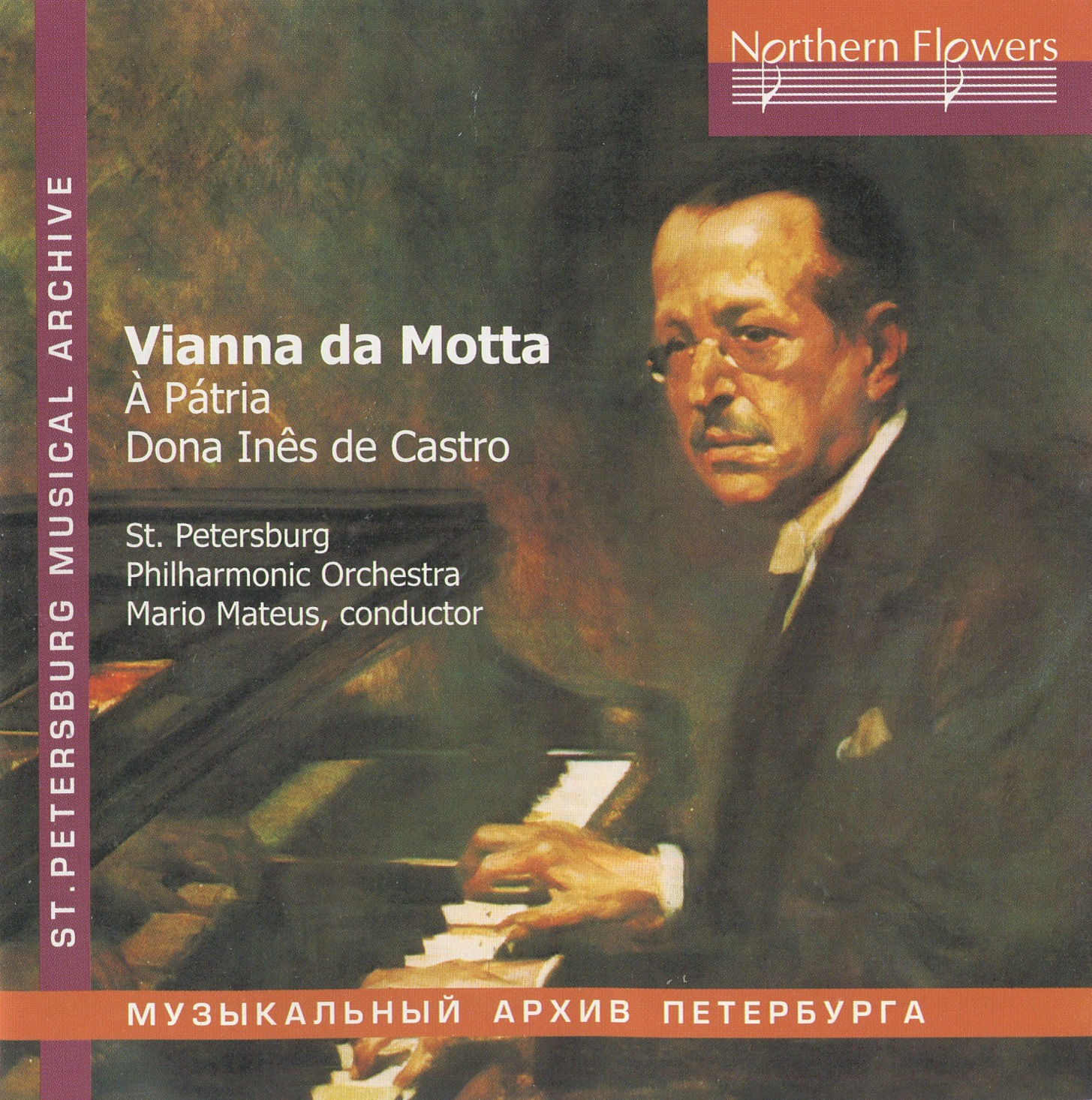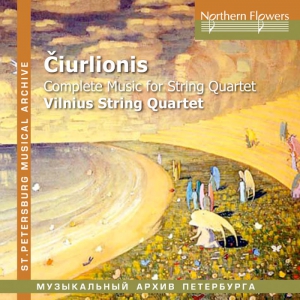Description
NF/PMA 9938
St. Petersburg Philharmonic Orchestra
Mario Mateus, conductor
Recorded at the St. Catherine Lutheran Church, St. Petersburg, July 26, 27 & 28, 2005
Sound recording and supervision: Alexey Barashkin
Design: Anastassiya Evmenova & Oleg Fakhrutdinov
José Vianna da Motta (1868–1948) Symphony À Pátria (“To the Fatherland”), 1895
- 1. Allegro eroico 9:34
- 2. Adagio molto 15:16
- 3. Vivace 6:43
- 4. Andante lugubre. Allegro agitato 12:54
- 5. Overture Dona Inês de Castro (1886) 12:43
Catalogue Number:
Number of Discs:
Date/Runtime: 57:17
Barcode: 4607052546751
Price: £11.99
José Vianna da Motta (1868-1948)
Symphony À Pátria
Overture Dona Inês de Castro
José Vianna da Motta is one of the most significant figures in the history of music in Portugal. He was active as a composer, pianist, teacher, administrator and editor. In many senses he marks the full flowering, late as it was, of romanticism in Portugal, and at the same time the beginning of a consciously nationalist approach.
Vianna da Motta was born on the island of São Tomé in 1868, but his family moved to Colares when he was two years old. He studied at the Lisbon Conservatory between 1875 and 1881, the year in which he gave his first public concert, including some of his own compositions, at the Salão da Trindade. His gifts were rapidly noted by Prince Fernando and the Countess of Edla, and under their patronage he left in 1882 for Berlin, where he enrolled at the Scharwenka Conservatory, studying piano and composition. He subsequently studied with Karl Schäffer, and visited Bayreuth in 1884, an experience which sparked a deep and continuing interest in the works of Wagner. In 1885 there took place his momentous meeting with Liszt, for whom he played. Vianna da Motta later recalled that “he did not stop me, but after I had finished said ‘A little more cautiously; don’t rush into the start. You can come back.’ This last sentence was my dream come true. I had been admitted to Liszt’s circle” .
After Liszt’s death, Vianna da Motta remained in Berlin, working with Hans von Bülow, becoming a close friend of Busoni and giving recitals with such celebrated performers as Sarasate and Ysaye. In 1892 he travelled to the United States and South America, returning only in 1906. He left Berlin in 1914, in order to take over the piano class at the Conservatory of Geneva, and returned to Lisbon in 1917, where he was appointed Director of the Conservatory, a position he occupied until 1938. He continued his extremely active teaching and concert career until 1945, and died in 1948.
The Symphony À Pátria (“To the Fatherland”) was completed in 1895, and is one of a series of three works inspired by the poetry of Camões, the others being the overture Dona Inês de Castro, from 1886, and the cantata Invocação das Lusíadas, Op. 19, begun in 1897 and finished during 1913-15. The choice of Camões, the national poet of Portugal, was far from mere jingoism on the composer’s part. For him, the symphony was part of an attempt to re-establish the glory of Portugal during this culturally and economically disheartening period — indeed, the fourth and final movement is entitled “Decadence — Struggle — Resurgence”. While linguistically the work shows the influence of Liszt and Wagner, as well as the heritage of the classical symphony and a nationalism inspired by the Russians, such grandiosity of conception inevitably recalls Mahler, who happened to be Vianna da Motta’s exact contemporary.
The first movement, Allegro eroico, is preceded by a quotation from Camões, beginning “Grant me now a high and noble sound, A grandiloquent and flowing style”, an invocation that expresses perfectly the music’s character. It is in tri-thematic sonata form, which, though it begins with certain echoes of the Russian “Five”, is highly Beethovenian in its development. F sharp major is the key of the work’s second and longest movement, an entirely remarkable achievement taking as its motto a love sonnet of Camões. It begins with a rapt peroration played by the strings divided into two quartets, one of them muted, which gives way to a rhapsodic creation whose harmonic procedures are of Lisztian character. What impresses above all, however, is the extraordinary timbral richness and detail of the movement, organized as it is as a continuous alternation of instrumental groups.
Quite different is the third movement, Vivace, built on two popular songs, As Peneiras from Viseu and O Folgadinho from Figueira da Foz. Both are of stylized urban character, with none of the modal “deviations” later to be explored so fruitfully by Lopes-Gra?a: one would hardly expect such an ethnological approach at this period. As material for a lively scherzo, however, they could hardly be bettered.
The fourth movement brings us back to the world of Liszt. The “Decadence” of the movement’s motto finds expression in a black, almost nihilistic Andante lugubre, whose simultaneously delicate and intense scoring once again shows Vianna da Motta’s orchestral mastery. The theme, given to the solo bass clarinet, is nothing less than a version of that of the first movement, whose pastoral second subject is also thereafter made to sound faded and unattainable. The “Struggle” that ensues is ferocious indeed, and to wrest from this a convincing victory is no mean feat. The composer does so in the final Maestoso by returning once more to the themes of the opening movement, which pass before us in glowing orchestral colours – a “Resurgence” indeed.
Inês de Castro, a celebrated and tragic figure in Portuguese history, was a Spanish noblewoman who was murdered in 1355, the centre of an amorous and political intrigue. Her widower husband, King Pedro I of Portugal erected two tombs at the Monastery of Alcoba?a, portraying in marble the story of her life.
The Overture Dona Inês de Castro (2), written eleven years earlier than the Symphony, is scored for a smaller orchestra than that work, but is also characterized by Vianna da Motta’s ever-remarkable understanding of the subtleties of instrumentation. Though the greater part of the musical discourse in this work is given to the strings, the contributions of the other sections of the orchestra, particularly the winds, are absolutely essential, structurally as well as colouristically.
The overture opens with a mysterious, Lisztian chromatic passage in the strings, which develops gradually into full five-part counterpoint before moving to a faster section with a memorable trumpet solo over tremolo strings. These two themes form the basic building blocks of the work, together with a martial but haunted Allegro. After the second (altered) statement of the Allegro, the trumpet’s theme returns, stated by the full orchestra fortissimo, followed by the opening theme, constantly winding down, as though drained of energy, and, unexpectedly, the Allegro theme once more, providing a note of radiant optimism.
Ivan Moody
MARIO MATEUS — conductor
Mário Mateus, has a long and distinguished career as a singer and conductor. He has studied in Portugal, Spain, Germany and Austria.
Besides his activity as a performer and pedagogue he often writes musical reviews and pedagogical articles for several newspapers and magazines, such as: Jornal de Not?cias, Diário de Lisboa, Litoral, RTP, O Público, Correio Pedagágico e o Professor.
As musical director he has conducted the following Orchestras: “Orquestra Sinfánica do Porto” (Porto Symphonic Orchestra), Porto Chambre Orchestra, Barroc Orchestra of Manheim, Heidelberg Highschool Music Orchestra, North Portugal Orchestra (Orquestra do Norte), Porto National Orchestra, “Filarmonia das Beiras”, Nacional Symphony Orchestra (Portugal), Pleven Philharmonic Orchestra, Polska Filharmonia Baltycka, Novosibirsk Philharmonic Orchestra, Longmont Symphony Orchestra (Denver), Musica Aperta (Bergamo), London Schubert Players, etc. And he has also conducted the following Choirs: CPO, CELUC, Contemporary Vocal Music Ensemble and the Música Reservata Ensemble. Presently he is the Title Director of the Choir and Orchestra of the Foundation “Conservatário Regional de Gaia”. He has conducted the Mozart Requiem, the Beethoven 9th Symphony, the Gustav Mahler 4th Symphony and Song of the Earth, the Arvo Part Passion, Igor Strawinsky Messe among many other pieces of contemporary authors. In Portugal he has been pioneer in promoting contemporary music, especially choral works.
Mateus took part in several International Festivals of Music, performed in the most important Portuguese cities and he also performed in Barcelona, Biarritz, Roma, Milano, Firenze, Heidelberg, Manheim, Innsbruck, Wien, Varsov, S. Paulo, Rio de Janeiro, Providence (USA), Macau, Gdansk, Novosibirsk, Denver (USA), etc.
Mateus is presently the Artistic Director of the “Orfeão Universitário do Porto”, and also the Pedagogical Director and the President of the Administration of the “Conservatário Regional de Gaia” Foundation and Artistic Director from International Festival of Gaia û Oporto.





